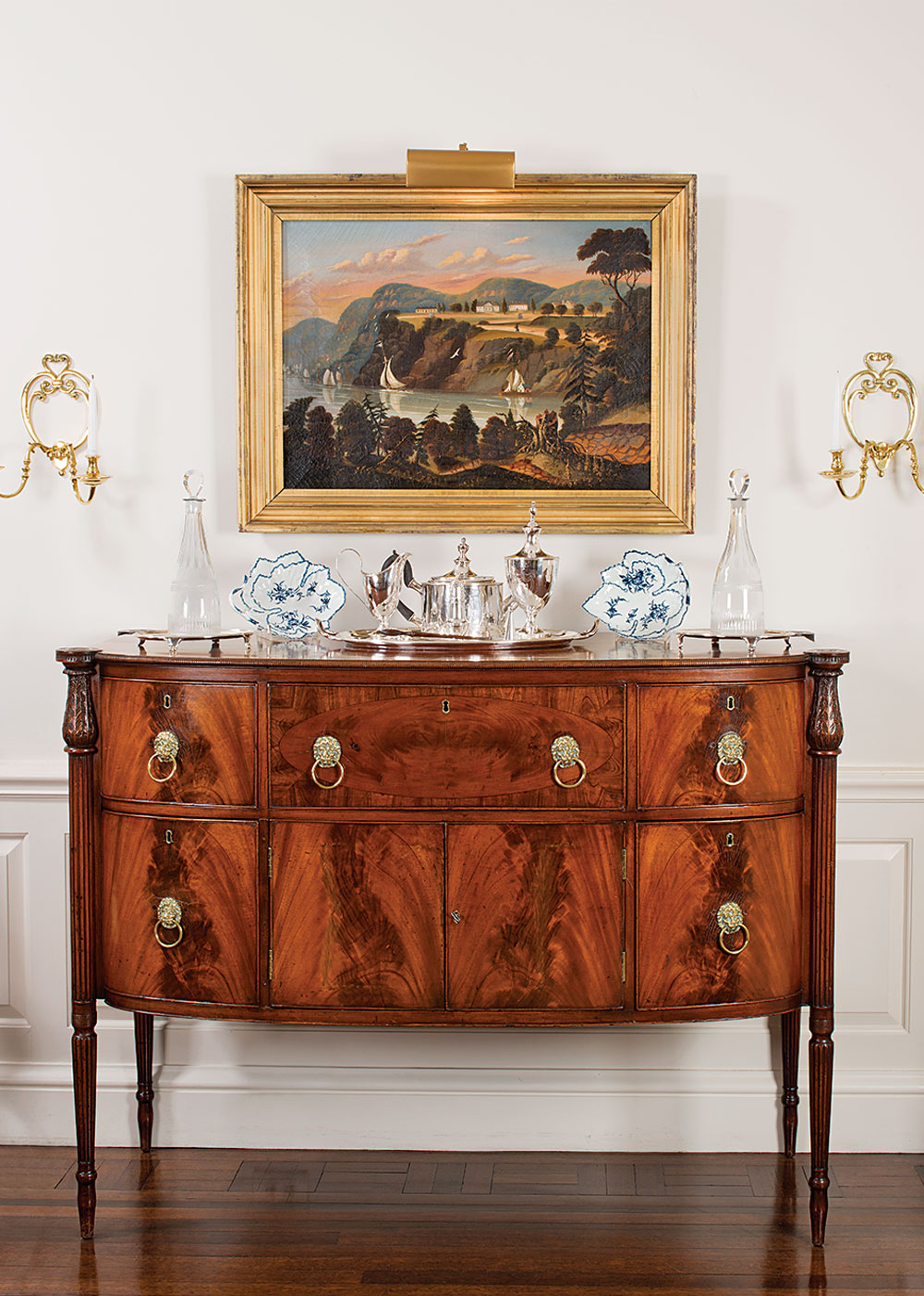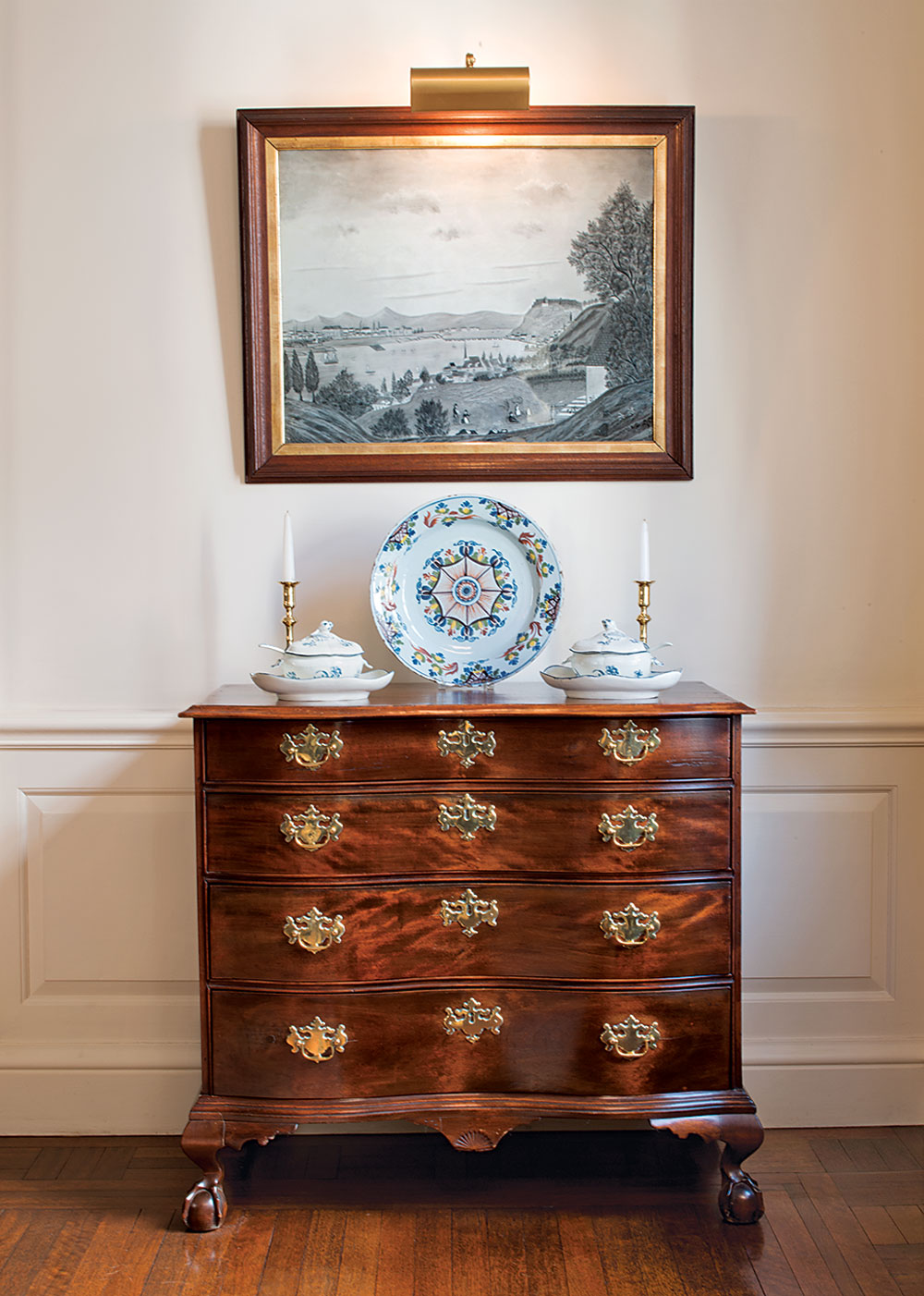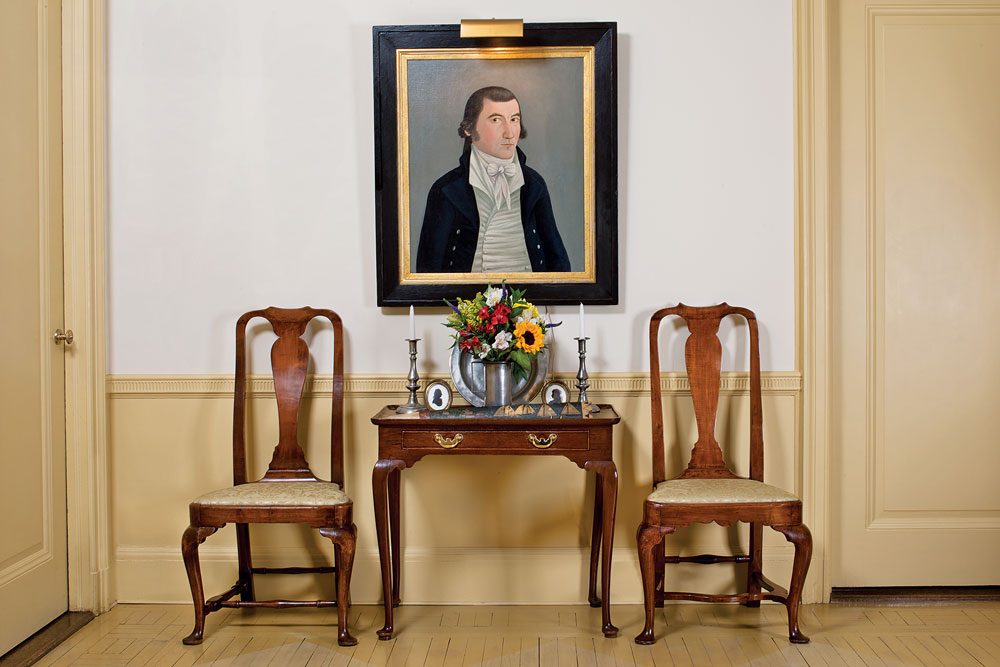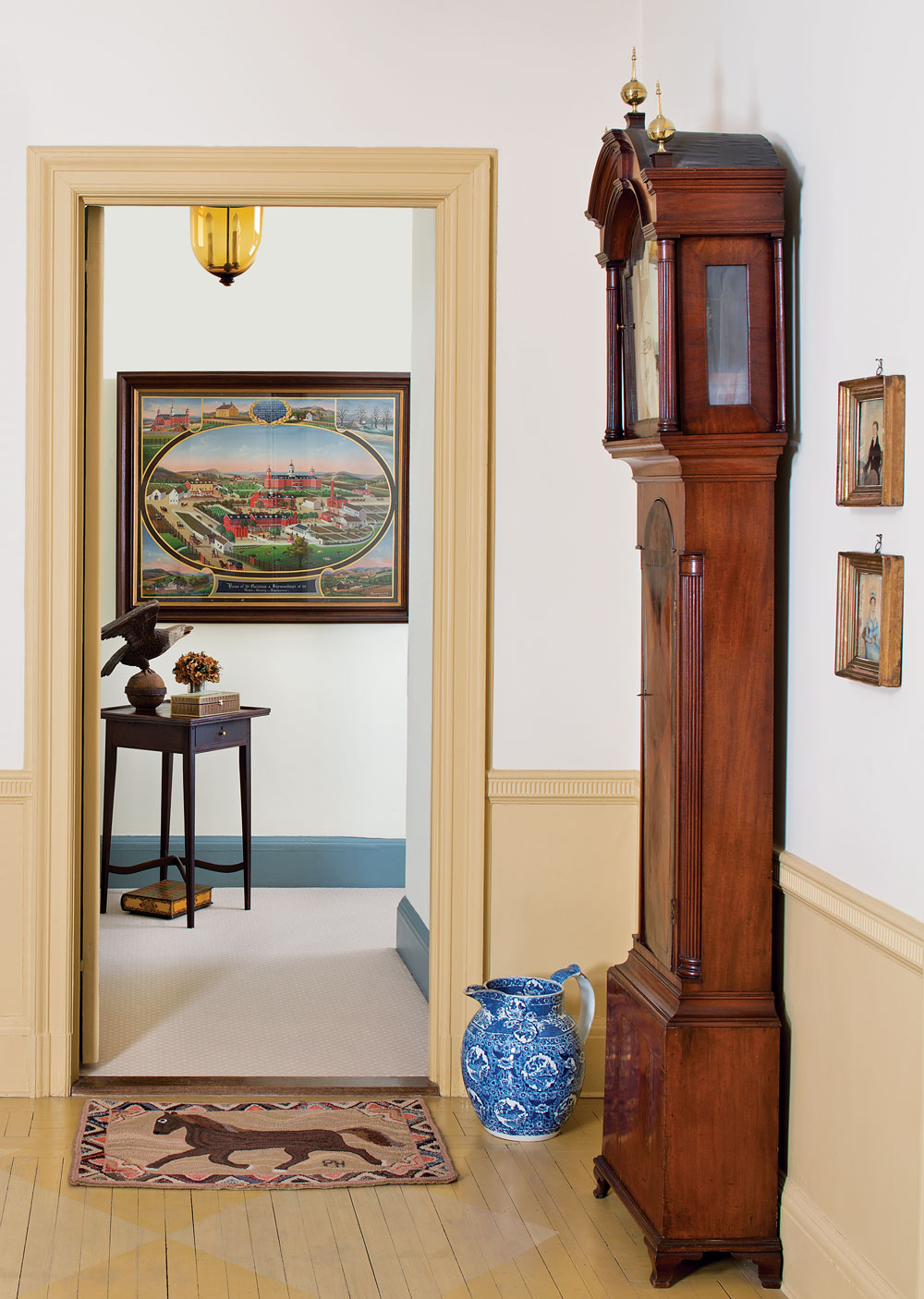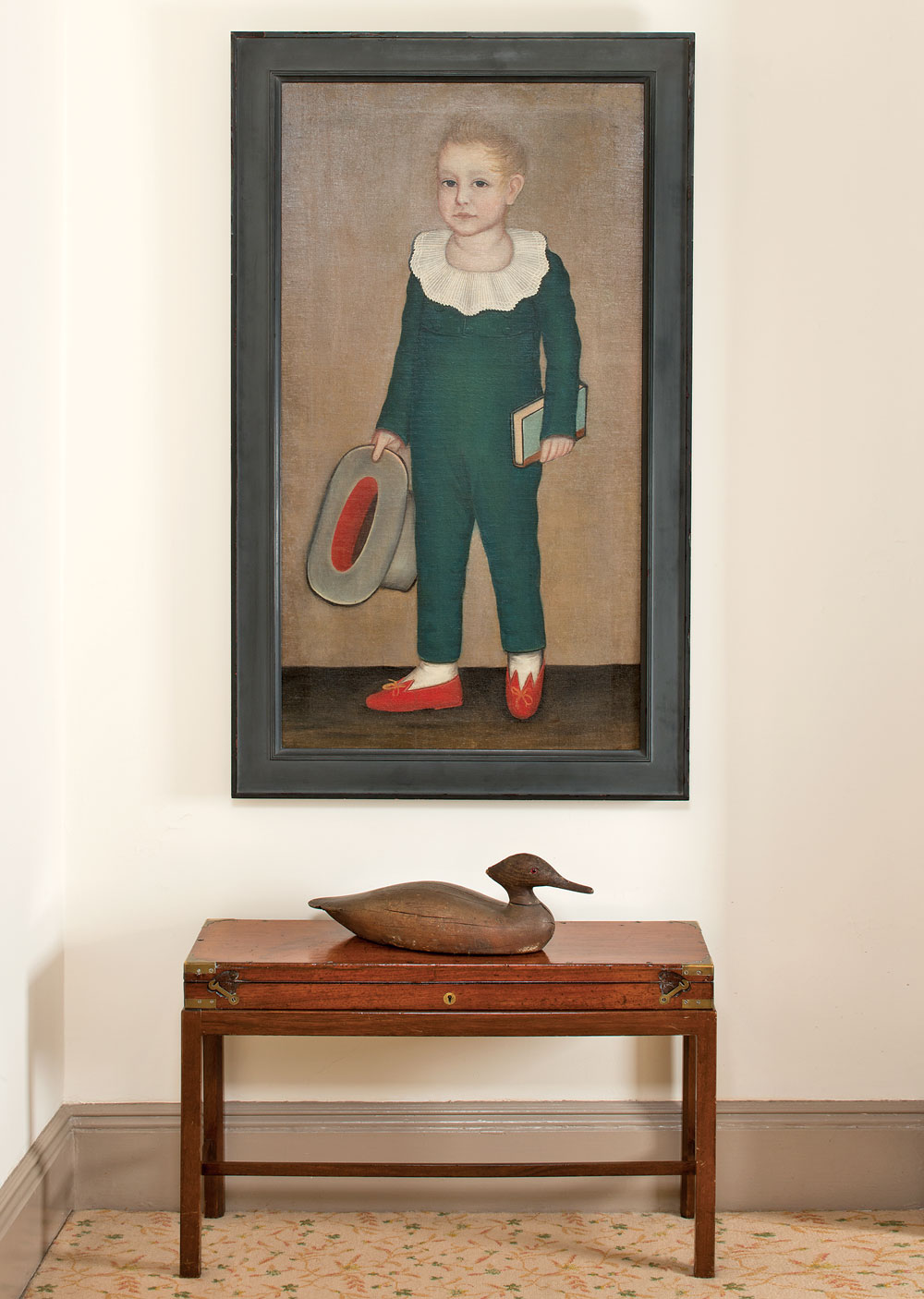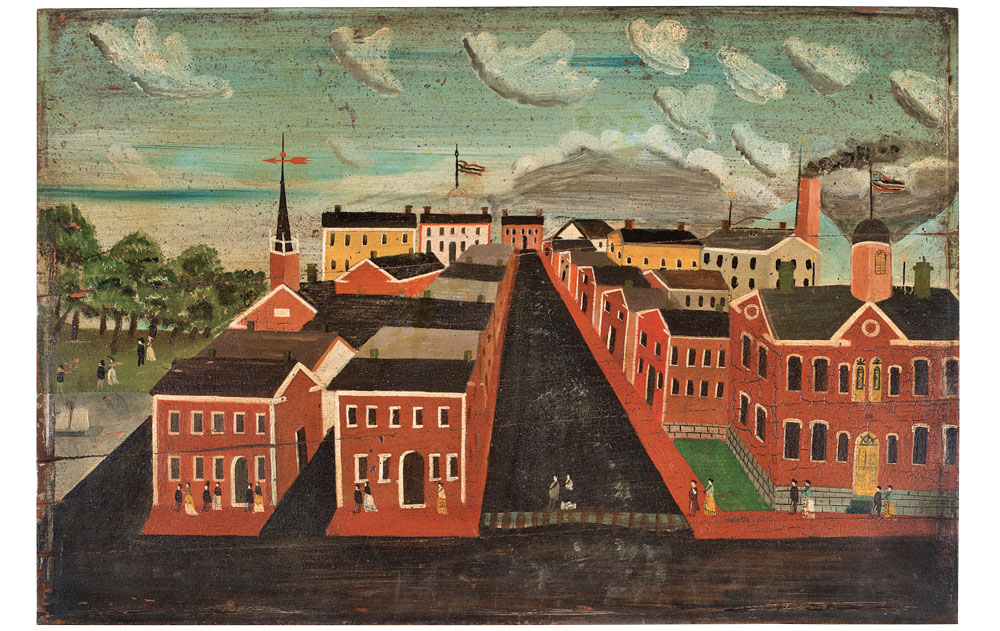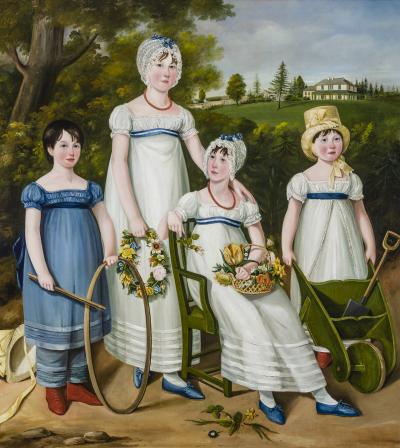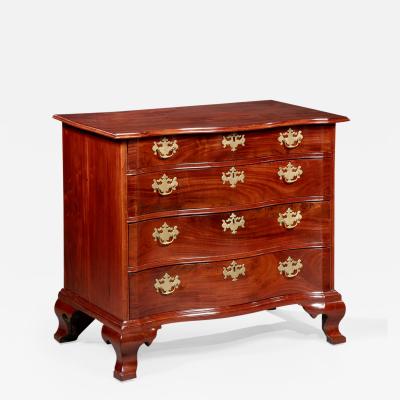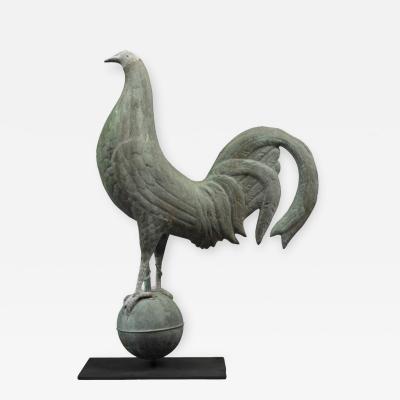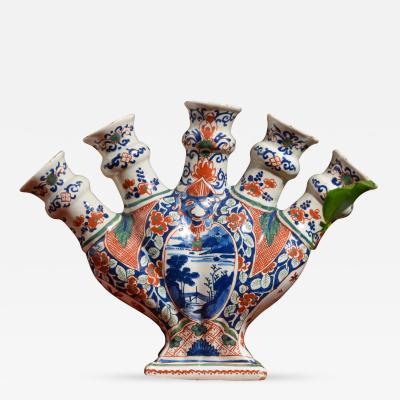Lifestyle: A Serendipitous Encounter Leads to…A Fancy for Folk Art
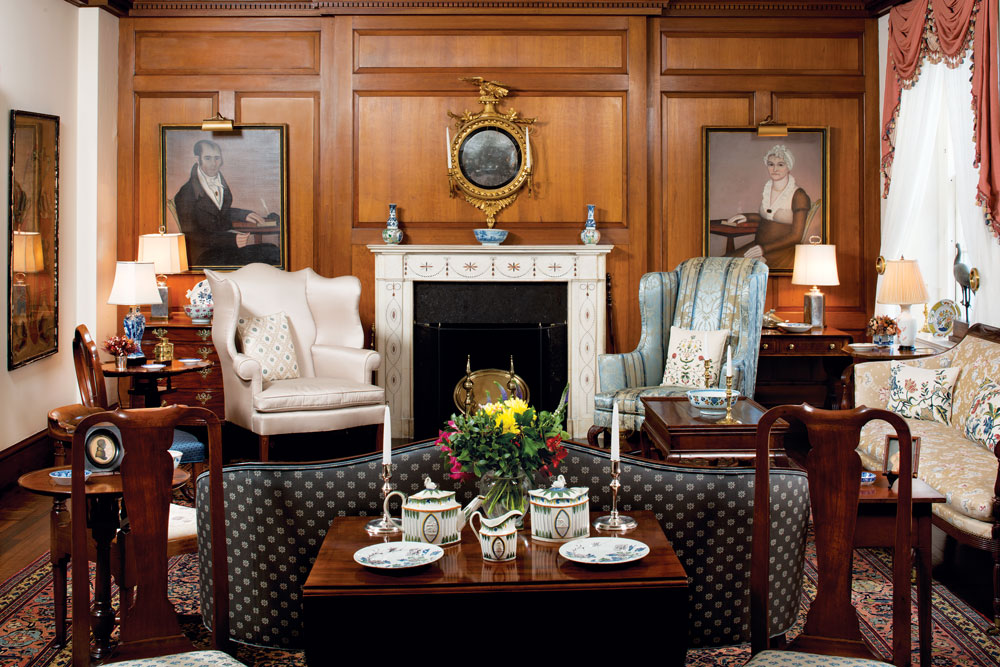
-
The portraits of John and Phebe Haynes, signed by Ammi Phillips (1787–1865) and dated 1814, provided documentation that helped identify Phillips as the artist of work previously associated with the anonymous “Border Limner.” Both retain their original frames and were purchased from Hirschl & Adler. In the foreground, Prattware and polychrome delft are displayed on a Duncan Phyfe (1770–1854)-style New York drop-leaf table; the couple finds that the colors of the ceramics complement the folk art.
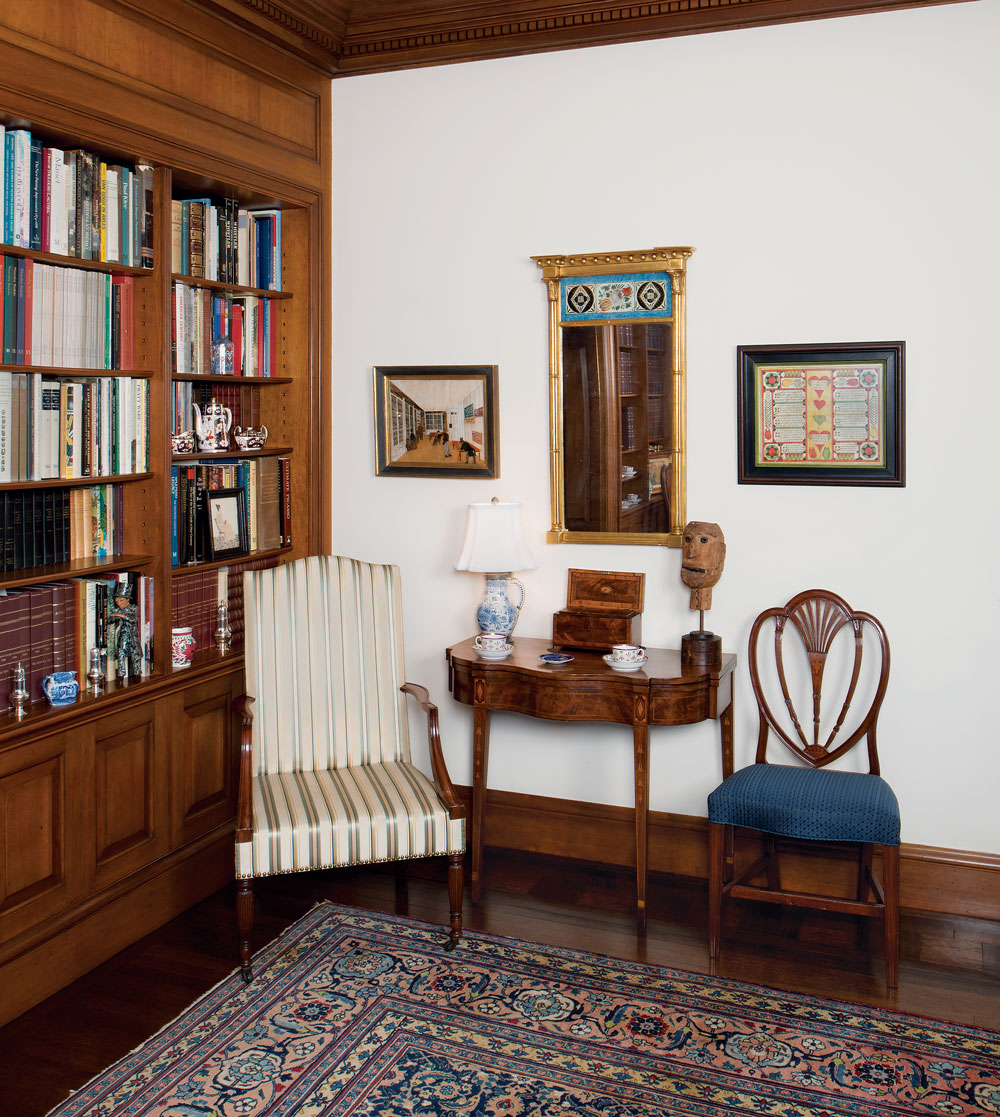
-
The couple owns a number of family antiques, including this Federal églomisé looking glass, a gift from the wife’s aunt, a collector of American furniture. Complementing it are other Federal-era antiques, including an inlaid Baltimore card table from Israel Sack, Inc.; one of a pair of eagle-inlaid Baltimore side chairs; and a Massachusetts lolling chair, signed “Abbott” under the upholstery on the crest, possibly for Daniel Abbott, who worked in Newburyport in 1809. The wife placed the roughly carved ventriloquist head within the formal corner for contrast. One of her favorite watercolors is a mid-nineteenth-century interior of an upstate New York library; a Pennsylvania family register flanks the other side of the looking glass.
It was a colorful hooked rug hanging in the window above a coffee shop on West 53rd Street in Manhattan that caught the young mother’s eye as she passed by. This serendipitous event in the 1970s would result in her devoting much of her time to what she later learned was the Museum of American Folk Art—now the American Folk Art Museum—and would alter the course of her and her husband’s interest in initially decorating and later collecting.
Shortly before, she had begun to attend auctions where she purchased affordable decorative items and “funny little paintings,” as her husband referred to them; they would later learn this material was identified as folk art. “I didn’t even know there was such a category,” says the wife. So when she saw the hooked rug in the window, it had a familiar look about it. Curious, she went up the stairs of the brownstone and began asking questions, which resulted in her being recruited as a volunteer. She has been heavily engaged in the museum’s educational and fundraising efforts ever since, and is an advocate for expanding awareness of folk art at the museum and through traveling exhibitions.
She and her husband had both grown up in households where antiques were appreciated; the husband, with English antiques, and she, with American country furniture. When they were married in the early 1960s, her mother made the clever suggestion that wedding guests should consider gifts from either Bloomingdales or the antiques shop of Ginsburg & Levy. The wife says, “Aunts and uncles followed my mother’s advice and we started out with some country furniture and household accessories.”
After the husband finished law school, the young couple relocated from New Haven, Connecticut, to New York City, where they moved into an apartment on 79th street. They began furnishing and decorating their new home with the guidance of the wife’s mother, moving away from the husband’s formal English furniture to what they refer to as the “sensibility” of American furniture and antiques.
As the couple developed their eye for quality, they began to more actively visit galleries and auctions. “We got to the point financially where we decided we could get one good piece a year,” says the husband. “We started with Israel Sack, working primarily with Harold and later with his brother Albert.” Adds the wife, “Our very first piece was the lowboy in the den. We agonized about it with Harold because it was a big investment at the time, but we were drawn to the Spanish feet and its beautiful patina.” The wife’s mother frequently supplemented their annual purchase with a Christmas gift consisting of an object of their choice.
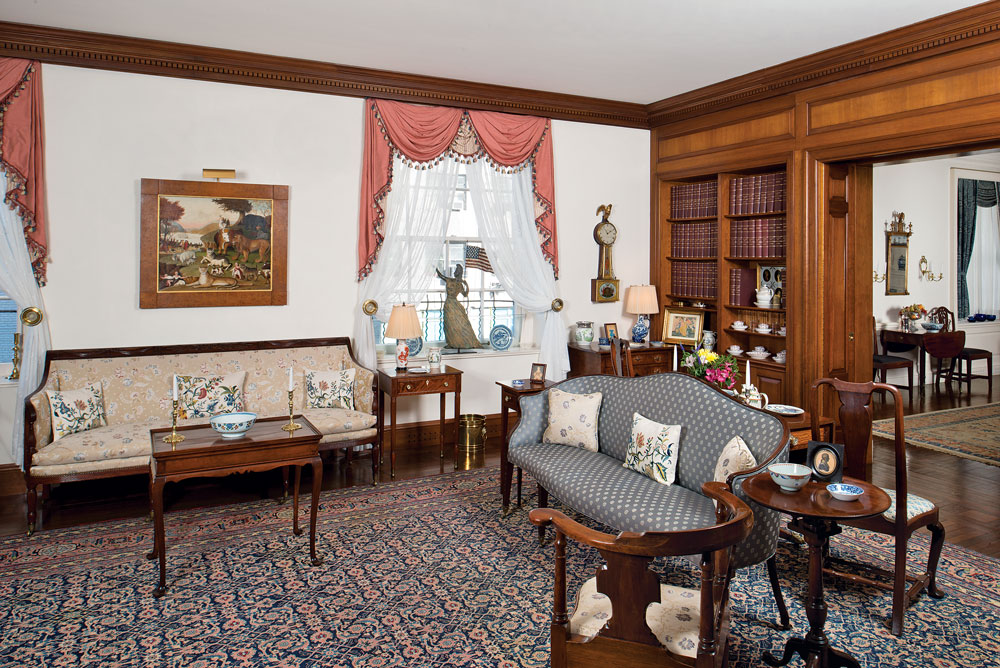
-
The rectangular tea table displays the delicate cabriole legs and complex molding profile of Connecticut examples. One of many things acquired from the late Fenton Brown, the table was among the first pieces of furniture the couple purchased when they moved into their apartment. The large Tabriz carpet was from Fenton and his partner Francis Bealey.
The Baltimore sofa with “cabriole” crest, illustrated in Helen Comstock’s American Furniture, was purchased from Bernard & S. Dean Levy. The Classical sofa is attributed to Duncan Phyfe of New York. The circa 1812–1816 presentation banjo clock was made by Aaron Willard Jr. (1783–1864) for Colonel Isaac G. Reed’s mansion in Waldoboro, Maine. Purchased from Israel Sack, Inc., it is illustrated in American Antiques from Israel Sack Collection, Vol. V, and in several volumes of Wallace Nutting’s Furniture Treasury. The miniature portrait of the girl in a blue dress, beneath the clock, is attributed to Joseph Whiting Stock (1815–1855).
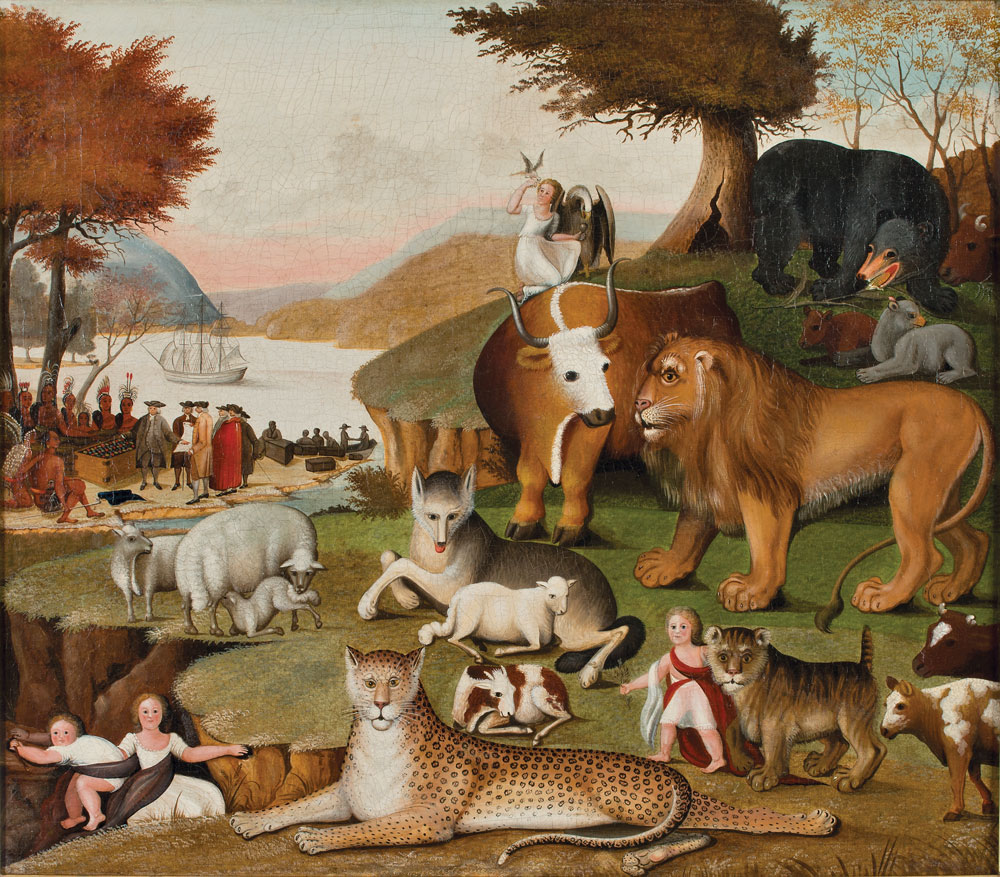
- When the couple saw this Peaceable Kingdom by Edward Hicks (1780–1849) in Marguerite Riordan’s booth at the 1982 Winter Antiques Show, they were instantly drawn to it, not only because it was a remarkable example, but because at its center is the image of a wolf; it’s the only Hicks they know to include a wolf in this location. There are few things they have acquired so quickly. The painting descended in the Janney family of Bucks County and Virginia.
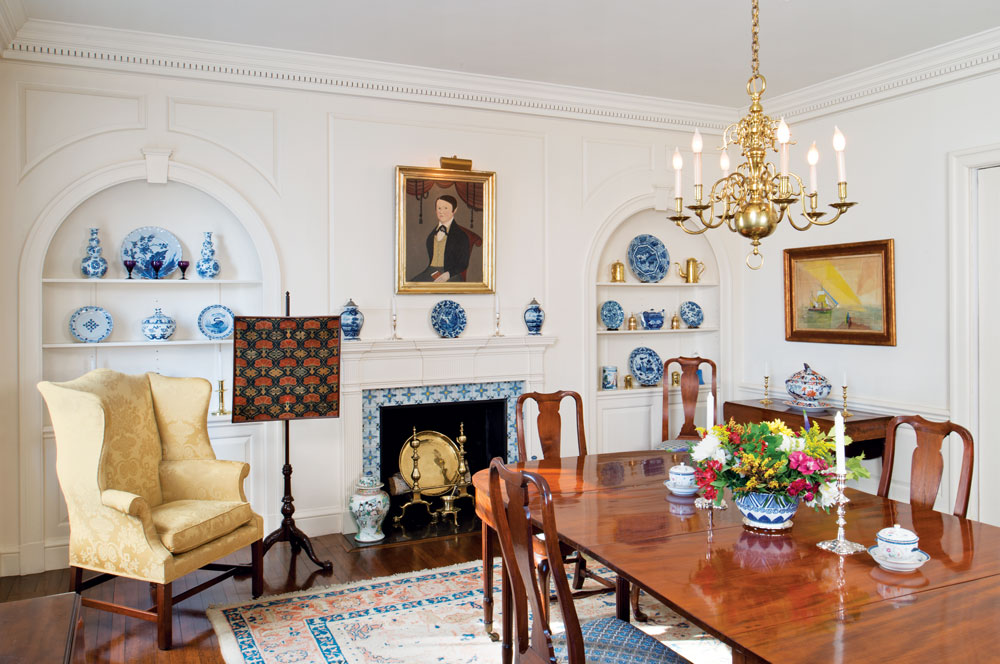
- When the couple hosts benefits for the American Folk Art Museum, their dining room is a natural gathering place for hors d’oeuvres and conversation, with the George Hartwell (1815–1901) portrait of a young man overseeing the celebratory atmosphere. Other notable items in the room include the circa-1760s fire screen from Albany, New York, with original crewelwork panel worked in a pattern of stylized carnations and medallions. The modernist work above the Pembroke table of a ship with overlays of tissue paper was by the husband’s mother, who trained with French Cubist painter Amedee Ozenfant (1886–1966). The Delft in the niches was acquired over time from dealers.
After a close call that involved their almost purchasing a dressing table with spliced legs, which the selling dealer discovered while cleaning the table, the couple began to rely heavily on the expertise of dealers. One of their closest advisors, who also became a good friend, was Fenton Brown, a collector and later a dealer in Essex, Connecticut. They first met Fenton on a trip back from a football game in Boston, when friends they were traveling with suggested they stop for a visit at his home. It was here they saw the tea table now in their living room. Subsequently, most of the furniture in their apartment and, later, their country house, came from Fenton and his partner Francis Bealey. They also continued to acquire furniture from Levy and Sack.
Their growing interest in American furniture and decorative arts coincided with the wife’s first visit to the Folk Art Museum. By the late 1970s and early 1980s, they had added more folk art than furniture to their city and country homes. While the couple was drawn to the aesthetics of folk art, the wife was also motivated by her love of the concept of the museum. “Bob Bishop was director at the time,” she says, “and it was through him that I became educated about folk art.” In 1980, when Bishop spearheaded the New York University graduate program in folk art studies, the first of its kind in the country, the wife took classes taught by Bishop at the museum. “It was an invigorating time,” she recalls.
|
|
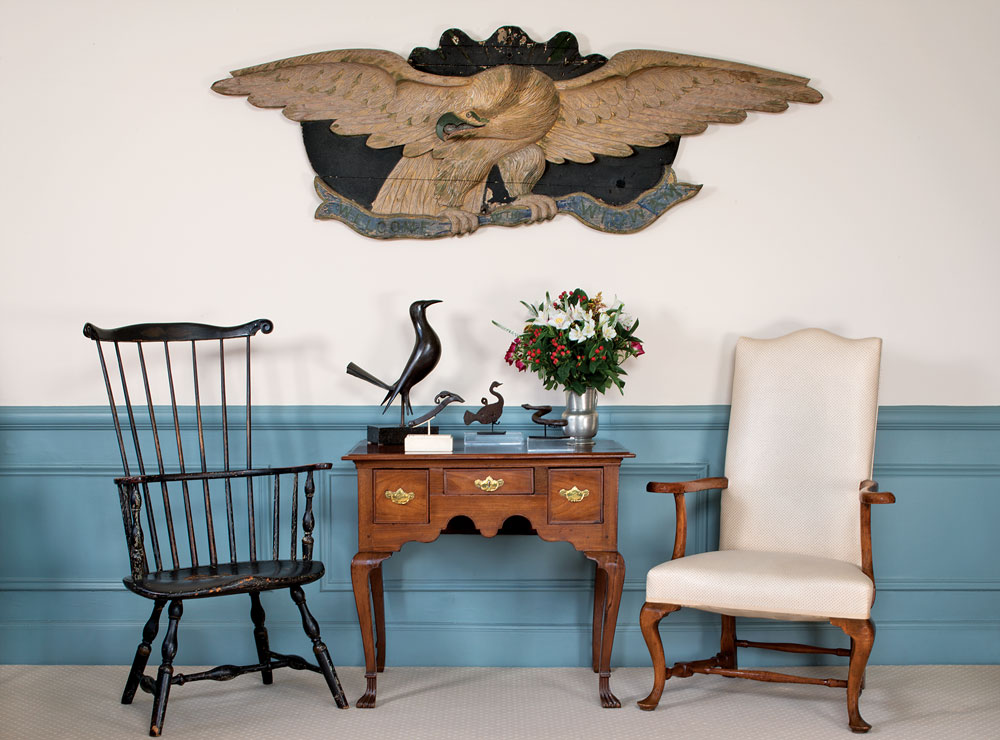
- On a wall of the couple’s den hangs a large stern-board eagle plaque. Originally carved for a ship, it later hung in a bar, where the words, “Welcome to the Wigwam” were painted onto the banner. The stories of how objects have been used through time add to their interest for the couple. The Queen Anne Spanish-foot dressing table was the couple’s first major acquisition. Acquired through Israel Sack, Inc., the wife recalls, “Because it was such a big investment for us at the time, we returned to the shop eight times before finally purchasing it from Harold.” The couple doesn’t have a lot of “smalls” in their collection, but those they do own have personality, such as the iron snake-shaped wrench and the ram’s-head connector displayed on the dressing table. Both were used for Conestoga wagons.
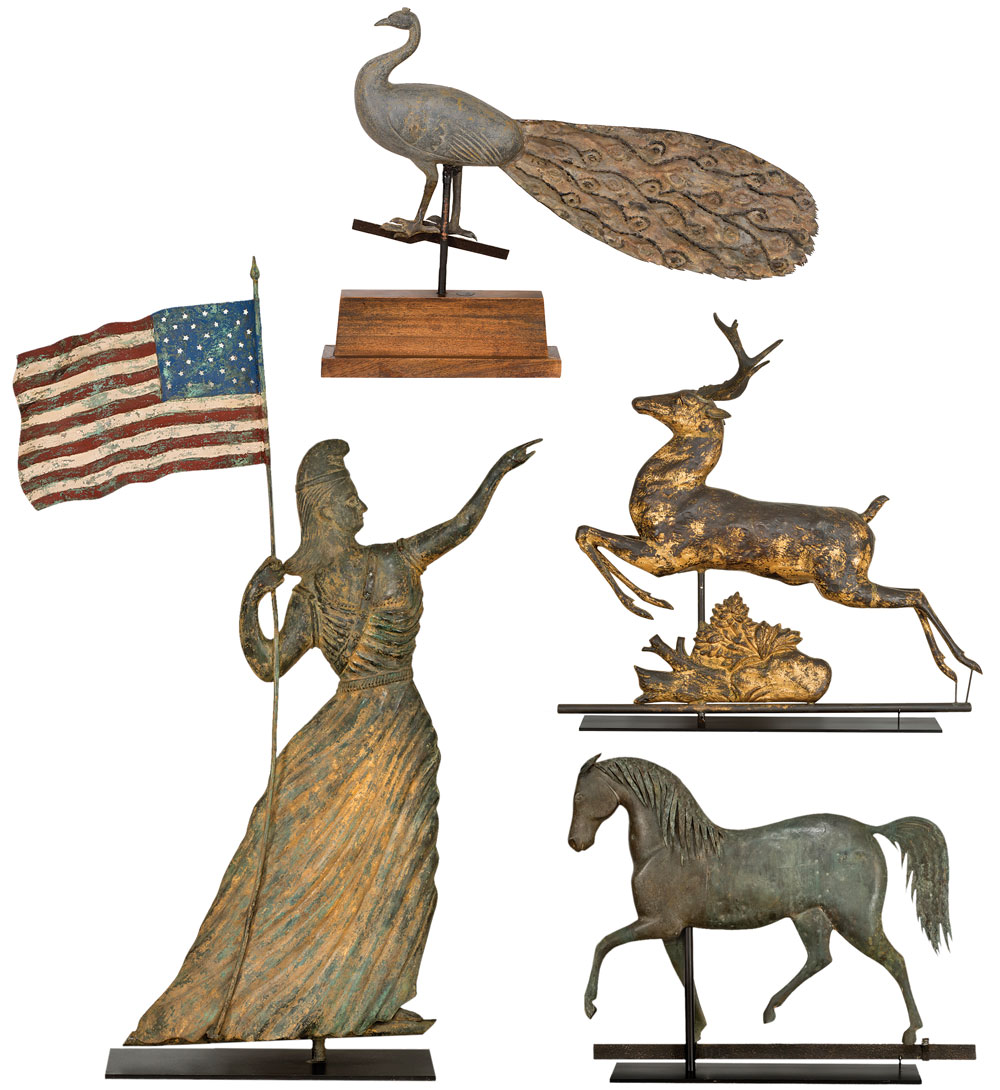
- The couple’s interest in weathervanes is due in part because they are a classic area of collecting and an area of interest for the American Folk Art Museum. This rare peacock weathervane, with traces of original gilding, was made by J. Howard & Co., W. Bridgewater, Mass., ca. 1860, and purchased from Peter Tillou. This Columbia, Goddess of Liberty weathervane, with original polychrome paint and gilding, was produced by A. L. Jewell & Co., Waltham, Mass., ca. 1875. The couple purchased it from Frank Miele. This full-bodied form, which retains much of its original gilding, was manufactured by Harris & Co., Boston, Mass., ca. 1870s, and acquired from Wayne Pratt. An exquisite example of a prancing horse with mane, this weathervane is stamped by J. Howard & Co., W. Bridgewater, Mass., ca. 1860, and was part of Marna Anderson’s collection.
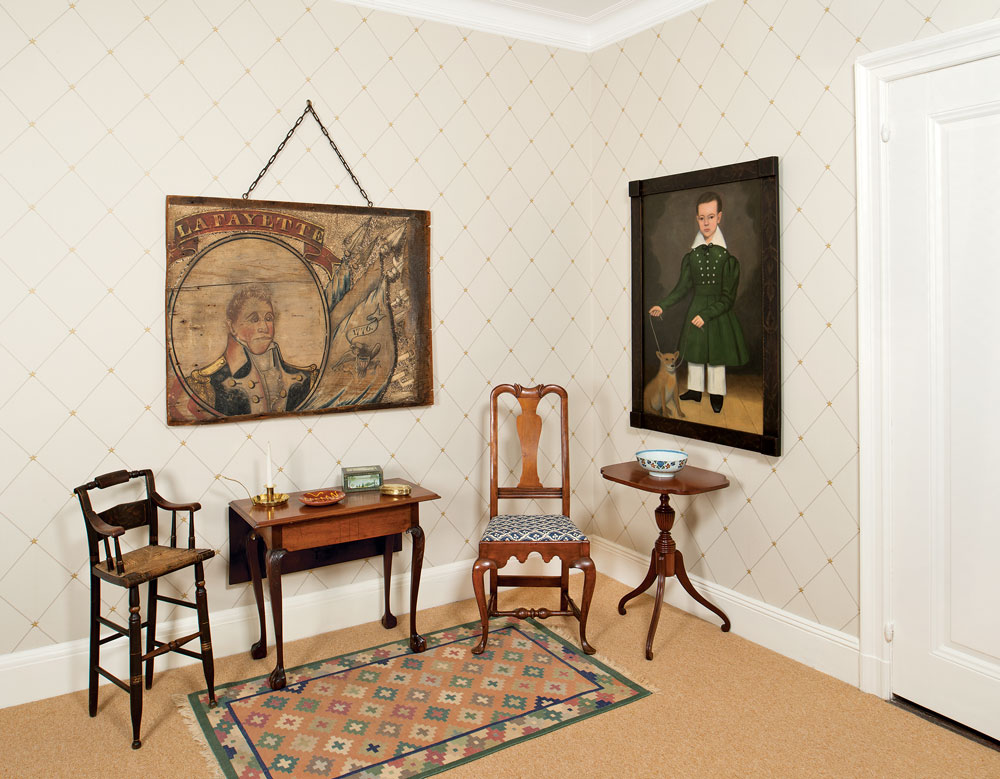
- A portrait of a boy and his dog, attributed to Erastus Salisbury Field, hangs opposite a double-sided tavern sign of General Lafayette. Though the couple usually acquires things together, in the case of the sign, the husband purchased it at auction thinking that his wife had also chosen it. In fact, she thought he was bidding on a different object. In the end, they were both pleased with the result, ending up with a wonderful sign. A rare, diminutive single drop-leaf table from Portsmouth, N.H., holds its own beside a masterfully designed Queen Anne Connecticut side chair.
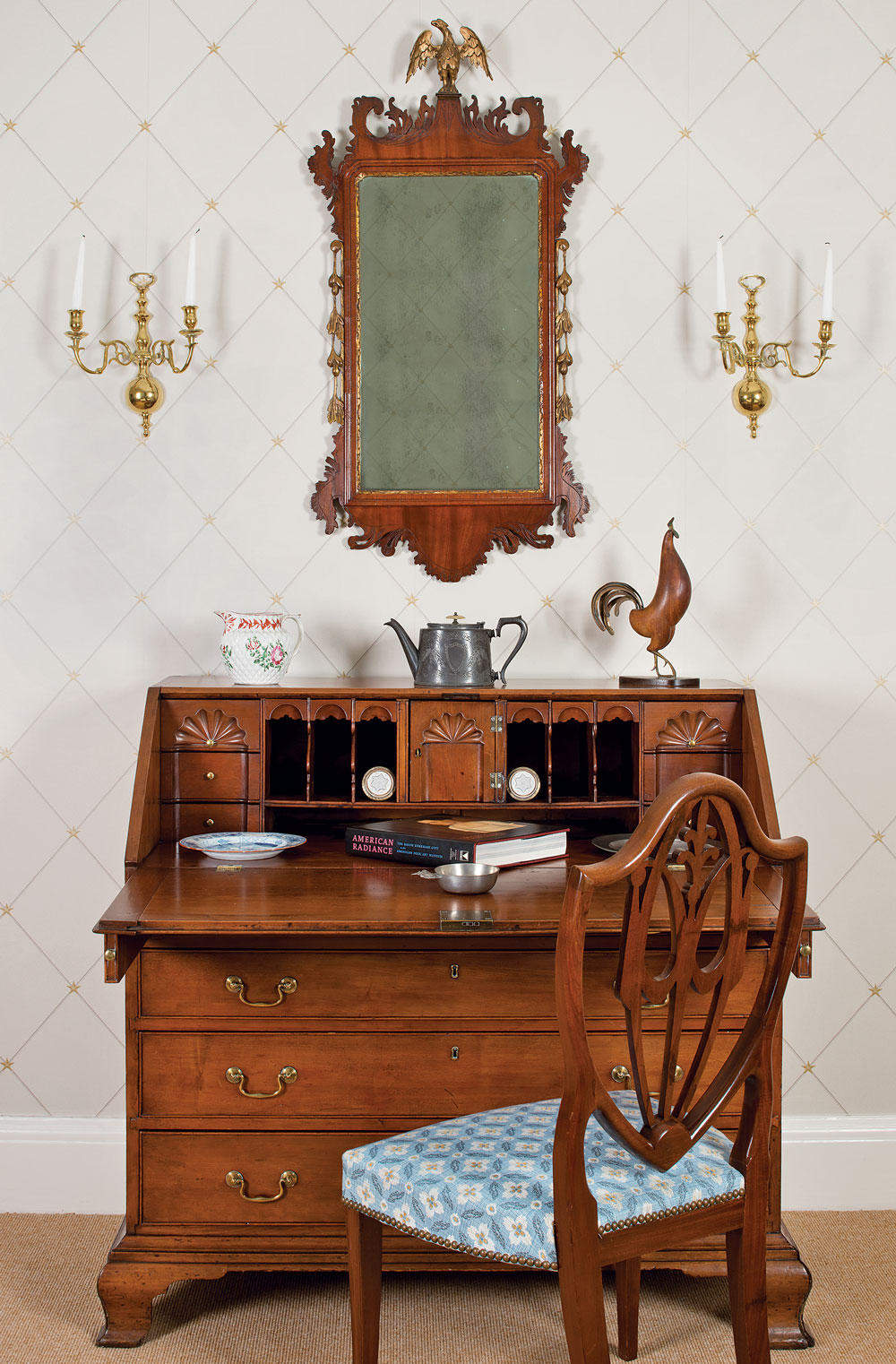
- This Newport, Rhode Island, desk is one of the husband’s favorite pieces of furniture in the collection. The original owner, Major John Wood, purchased furniture from John Townsend (1733–1809); it’s possible this desk is associated with his shop. The desk is from Francis Bealey American Arts. A looking glass from the wife’s mother hangs above the desk, at which is placed a New York side chair.
Begun in 1961 by a small group of early collectors, who included Adele Earnest, Cordelia Hamilton, Herbert Waide Hemphill Jr., Joseph B. Martinson, Marian Willard Johnson, and Arthur M. Bullowa, the wife recalls that though the museum “was originally comprised of one floor—with two tiny rooms,” it was put on a more professional footing when Bishop became the director in 1977. She notes, “When collector Ralph Esmerian became involved in the 1980s, he became the museum’s main financial supporter, also purchasing and donating many examples of important folk art that came to form the backbone of its collection.” The couple feels fortunate to have been involved during these early years, becoming friends with Esmerian and other collectors and learning from their expertise.
Through the years, when purchasing folk art, the couple has worked primarily with Hirschl & Adler Folk, Marguerite Riordan, and Peter Tillou. While they are drawn to the aesthetic qualities of folk art and fell, says the wife, “head over heals” for Edward Hicks’ Peaceable Kingdom and Ammi Phillips’ portrait of Frederick Gale, the couple do not consider themselves collectors. Says the wife, “…we consider ourselves mavericks. We attend the Winter Antiques Show and, more recently the New Hampshire Americana Week in Manchester, but we don’t usually go to many other antiques shows across the country.” Adds the husband, “If we see something in an ad then we’ll contact the dealer, but we never expect to be seen as true collectors.”
The wife credits their association with the American Folk Art Museum for their deeper knowledge and appreciation of folk art. “Clearly there is no way we would have acquired the Hicks, for example, without exposure to the museum.” It’s this educational component that they believe has been incredibly valuable to them through the years. This is why the wife feels so strongly about supporting the educational efforts at the museum, noting, “Folk art is the art of the people. People in all walks of life can connect with it. Using folk art as a means of educating individuals about art and society is what makes the museum important.”
The wife is particularly proud of the museum’s outreach with traveling exhibitions, citing the 2016 American Made: Treasures from the American Folk Art Museum at Crystal Bridges Museum of American Art, the first folk art exhibition ever held at the Bentonville, Arkansas, museum, and the broadly traveled Self-Taught Genius show sponsored by the Luce Foundation as part of its 75th anniversary initiative. She notes that much of the American Folk Art Museum’s recent success is due to its relatively new director, Anne-Imelda Radice, and her strong support of research and education, along with her ability to secure funding from resources such as the Ford Foundation and governmental entities. Such initiatives have contributed to increased exhibition programming, both through outreach and at the museum’s 2 Lincoln Square location, and a new Collections and Education Center in Queens, which opened in 2015. This center houses the archives and library and a changing exhibition space, further expanding connections within communities.
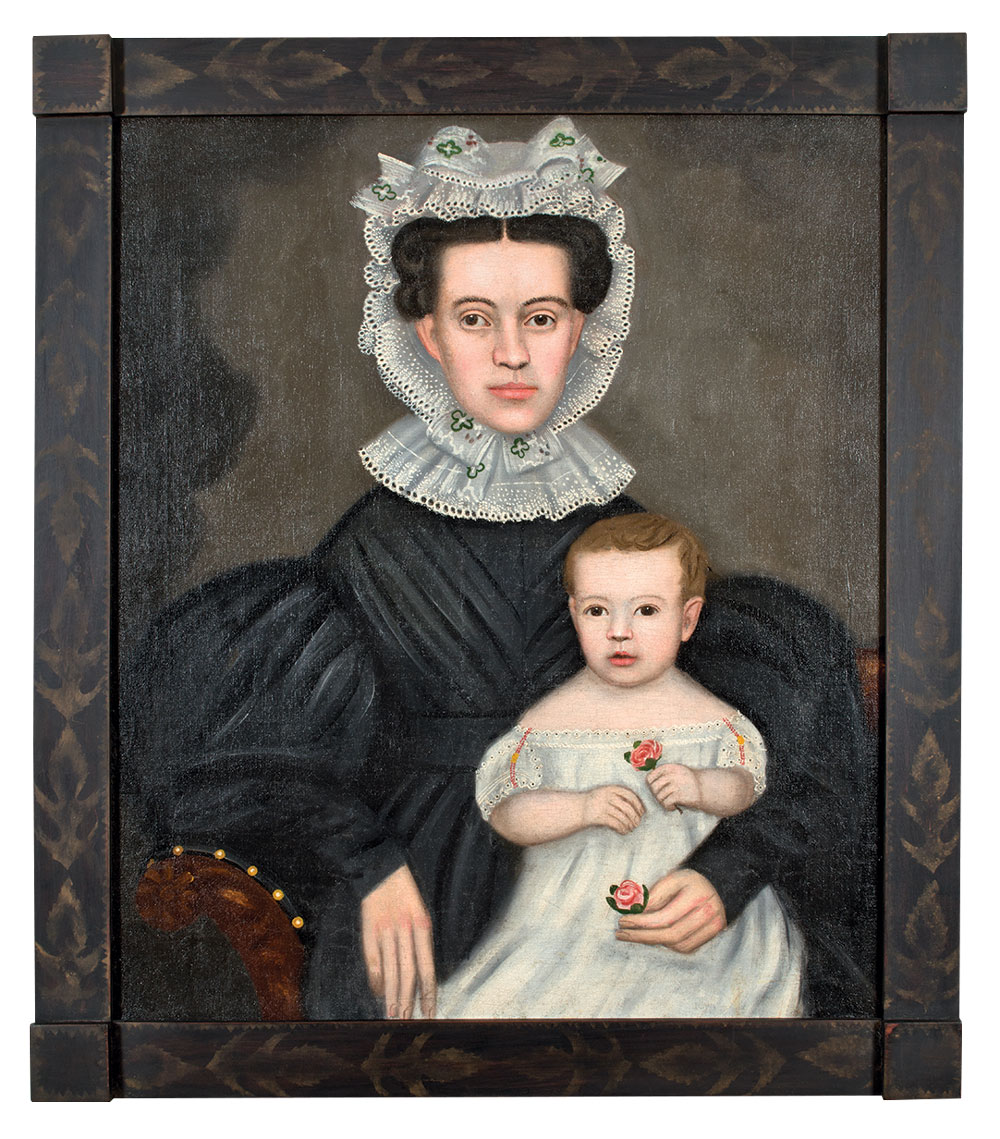
- This portrait from Hirschl & Adler Folk, of a mother and her child, each holding a rose, is attributed to Erastus Salisbury Field (1805–1900), an itinerant artist active primarily in Massachusetts, and who also painted in Vermont and New York.
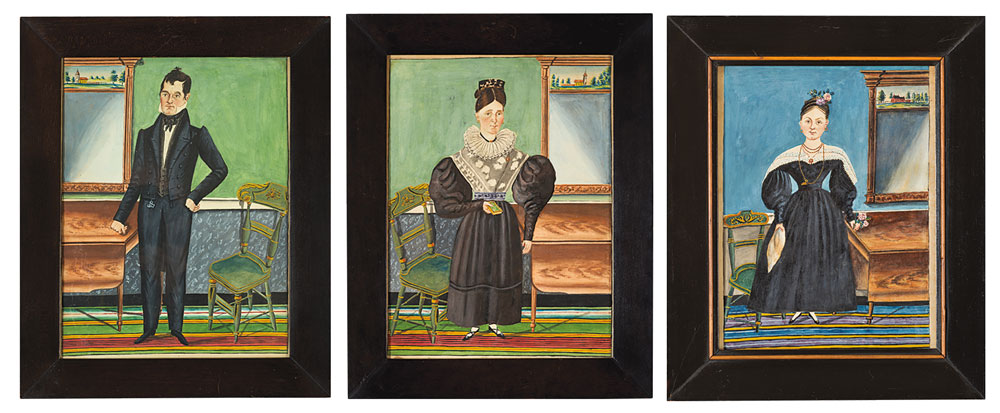
- These three watercolor portraits are of Louisa Duinges Hamm and her husband John, and John’s maiden sister, “Aunt Hamm.” Painted by Jacob Maentel, circa 1830, in Lititz, Pennsylvania, his abstract works are united in their furnishings; the shared ingrain carpet, table, and looking glass for the couple, and the same elements, but with a blue color scheme, for John’s sister. All three Hamms arrived in America from Germany in 1827. From Hirschl & Adler Folk.
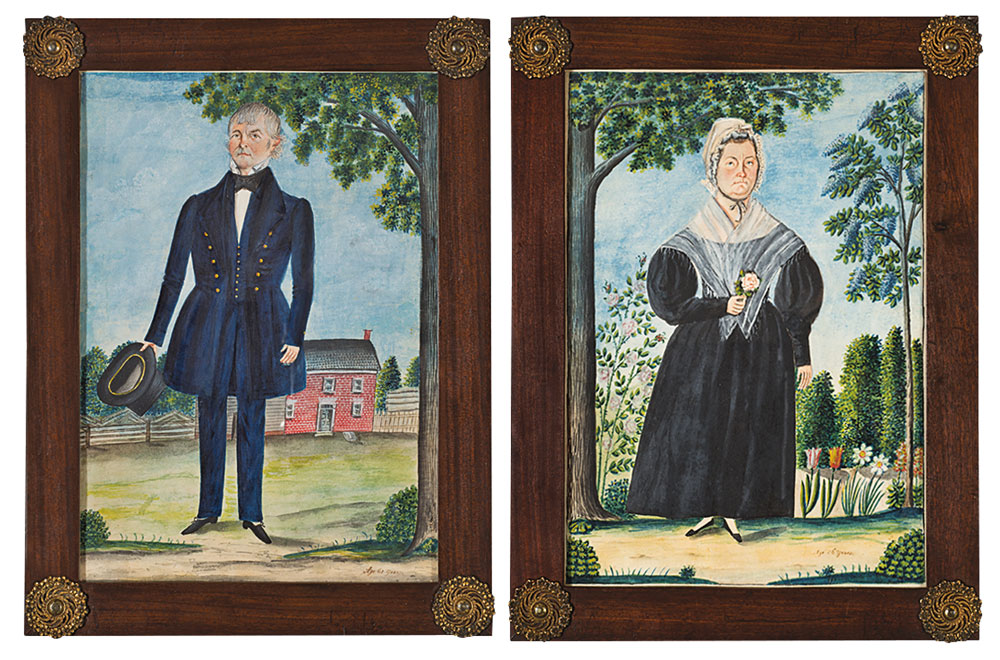
- This pair of portraits is attributed to German immigrant artist Jacob Maentel (1763–1863). They display some of his more elaborate landscape backgrounds and are in their original frames. The watercolors were owned by Nina Fletcher Little.
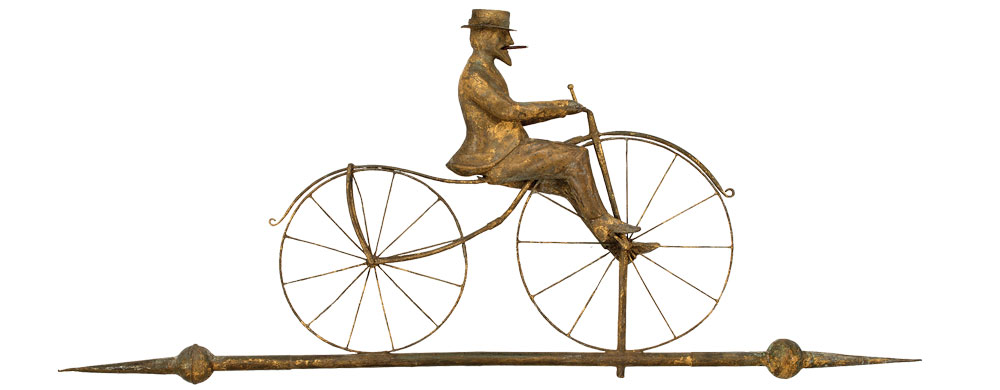
- The couple purchased this bicycle weathervane at a Sotheby’s auction. It had been owned by David Davies, a long time board member of the American Folk Art Museum, and his partner Jack Weeden. Says the wife, “David had a great weathervane collection and we were very pleased to have something he had owned.”
The wife notes, “Other museums are beginning to recognize the attraction of folk art in that it tells a story, and has an impact that is different than art by classically trained artists.” The husband concurs, stating, “Folk art represents the cultural development of the country in a way that other art is less likely to do because folk art is a less elitist form of expression.” Notes the wife, “It’s in this way that folk art falls into the current museum frame of thought about reaching new levels of society and attendees.”
Part of the couple’s interest in collecting folk art extends to engaging new and young enthusiasts, and, to that end, they regularly host events at their homes. “I’m very excited that the museum now has a new generation of trustees, in addition to a large following of young members in a group called “Young Folk.” Says the wife, “They’re becoming involved much quicker than it took us; there is so much more exposure and educational opportunity now and it’s a very exciting time to be collecting folk art.”
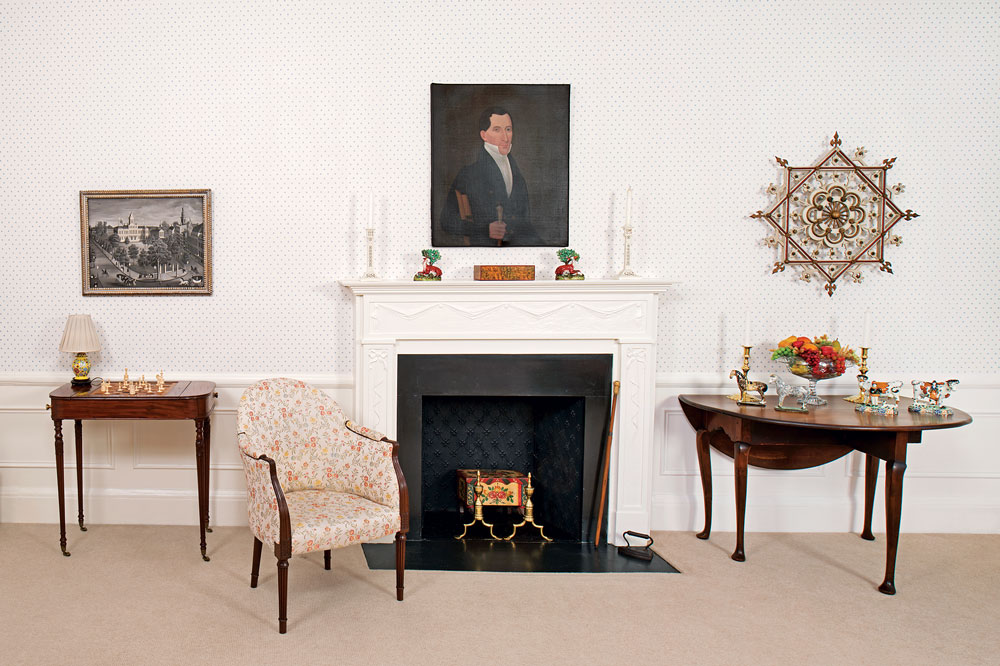
- The portrait of Mr. Smith of North Carolina was the first oil painting the couple purchased. It descended with a note from Mr. Smith instructing the artist to accurately paint his glass eye. Acquired from Marna Anderson when she had her shop in Brooklyn, it descended with the walking stick Mr. Smith holds, and which now rests against the fireplace surround. The painted box and andirons were both from Fenton Brown, as was the Queen Anne New England drop-leaf table, the Federal Philadelphia bergere, and the gaming table. The latter descended in the Wheelock family of Boston and has an unusual sliding top with an underside fitted with a game board. Above the table is one of the couple’s sandpaper drawings, and a “snowflake celebration” carving by John Scholl (1827–1916), from Olde Hope Antiques, is hung above the drop-leaf table. The polychrome ceramics are from a collection displayed in nearby cupboards.















